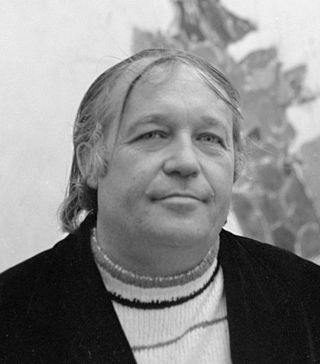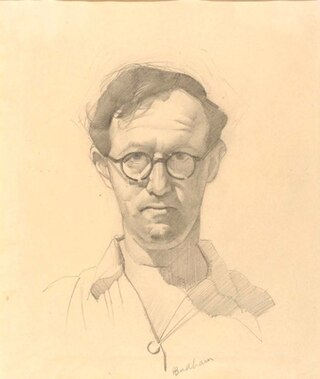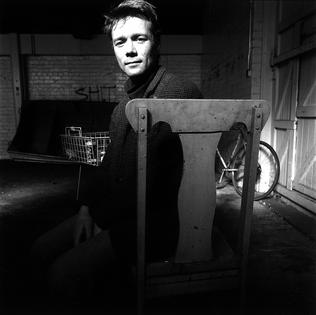
Mark Rothko, born Markus Yakovlevich Rothkowitz, was a Latvian-born American abstract painter. He is best known for his color field paintings that depicted irregular and painterly rectangular regions of color, which he produced from 1949 to 1970.

Samuel Lewis Francis was an American painter and printmaker.

Franz Kline was an American painter. He is associated with the Abstract Expressionist movement of the 1940s and 1950s. Kline, along with other action painters like Jackson Pollock, Willem de Kooning, Robert Motherwell, John Ferren, and Lee Krasner, as well as local poets, dancers, and musicians came to be known as the informal group, the New York School. Although he explored the same innovations to painting as the other artists in this group, Kline's work is distinct in itself and has been revered since the 1950s.

Frederick William Leist was an Australian artist. During the First World War, he was an official war artist with Australian forces in Europe.
Mel Bochner is an American conceptual artist. Bochner received his BFA in 1962 and honorary Doctor of Fine Arts in 2005 from the School of Art at Carnegie Mellon University. He lives in New York City.
Jessica Rankin is an Australian artist who lives and works in New York. She has participated in numerous group exhibitions in the US, Europe and Australia, including White Cube, London (2007), MoMA PS1, New York (2006) and Franklin Artworks, Minneapolis (2005). Rankin is best known for her organdy embroidery, although she also produces works in other mediums.
Norman Lloyd was an Australian landscape painter.
George Feather Lawrence (1901–1981) was born in Sydney, Australia and for many years was regarded as one of the foremost painters in the impressionist style. He studied under Julian Rossi Ashton at the famous Sydney Art School in the old Queen Victoria Building; and later in London and Paris.

Artists' camps flourished around Sydney Harbour in the 1880s and 1890s, mainly in the Mosman area making it "Australia's most painted suburb", but died out after the first decade of the twentieth century. They developed as a result of the enthusiasm for painting en plein air fostered by the Barbizon and Impressionist movements in France in the second half of the 19th century, and were modelled on the artists' colonies which grew up in France and parts of the British Isles. In them, free-spirited young men gathered to live cheaply together in the open air, trying to capture the beauty of their surroundings in paintings and drawings. Financial stringency during the depression of the 1890s made life in the camps even more attractive for Australian artists trying to establish themselves in a difficult market.
George Earl Ortman was an American painter, printmaker, constructionist and sculptor. His work has been referred to as Neo-Dada, pop art, minimalism and hard-edge painting. His constructions, built with a variety of materials and objects, deal with the exploration off visual language derived from geometry—geometry as symbol and sign.

Tania was a Polish-born Jewish American abstract painter, sculptor, collage artist and painter of city walls. Primarily working in New York City, she was known by several married names over the course of her career, but decided as of 1958 to use simply her first name, Tania. She was active in the New York art world from 1949 to 1982, but is perhaps best known for her 13-story geometric wall painting of 1970, which still stands at the corner of Mercer and Third Streets in Greenwich Village, Manhattan, New York. In 1966, she became a founding member of City Walls, Inc., a non-profit organization that commissioned abstract artists to paint walls around New York City, and which would later become the Public Art Fund.

Percy Alexander Leason was an Australian political cartoonist and artist who was a major figure in the Australian tonalist movement. As a painter and commercial artist his works span two continents.

Thornton Willis is an American abstract painter. He has contributed to the New York School of painting since the late 1960s. Viewed as a member of the Third Generation of American Abstract Expressionists, his work is associated with Abstract Expressionism, Lyrical Abstraction, Process Art, Postminimalism, Bio-morphic Cubism and Color Field painting.
Robert Richenburg was an abstract expressionist artist based in New York City, whose paintings were widely acclaimed in the 1950s and 1960s. While a student of Hans Hofmann, Richenburg exhibited at the Museum of Non-Objective Painting in 1950. The following year, he participated in the historic Ninth Street Art Exhibition, and subsequently taught at Pratt Institute along with Franz Kline, Adolph Gottlieb, Jack Tworkov, Philip Guston, Milton Resnick and Tony Smith. By 1961, critic Irving Sandler declared that "Richenburg emerges as one of the most forceful painters on the New York Art Scene." The Whitney Museum, the Museum of Modern Art and the Philadelphia Museum of Art, among others, purchased his work.

Dore Ashton was a writer, professor and critic on modern and contemporary art.

The Last Judgement is a triptych of oil paintings by the British artist John Martin, created in 1851–1853. The work comprises three separate paintings on a theme of the end of the world, inspired by the Book of Revelation. The paintings, The Plains of Heaven, The Last Judgement, and The Great Day of His Wrath, are generally considered to be among Martin's most important works, and have been described by some art critics as his masterpiece.

Herbert Edward Badham (1899-1961) was an Australian realist painter and art teacher.

David Larwill (1956–2011) was an Australian artist recognisable by his distinctive and exuberant style based on bold colour, stylised figures and simplified form. Although best known as a figurative expressionist painter, Larwill was also a draughtsman and printmaker of note. He produced many drawings, watercolours, ceramics and sculptures as well as etchings, lithographs and screenprints. In a career that stretched over 30 years, Larwill held over 25 solo exhibitions and participated in scores of group shows.

Lionel Hornibrook Jago (1882–1953) was an Australian artist active between 1910 and 1950.

The Exhibition of Australian Art in London was a show organised by the trustees of the Art Gallery of New South Wales (AGNSW), notably Julian Ashton, and financially supported by the philanthropist Eadith Walker. Held at London's Grafton Galleries between April and September 1898, it featured 371 artworks made in Australia by 114 artists, and was the first major exhibition of Australian art to occur internationally.













